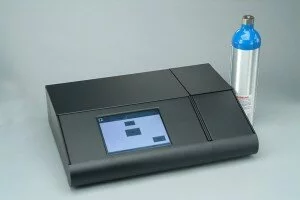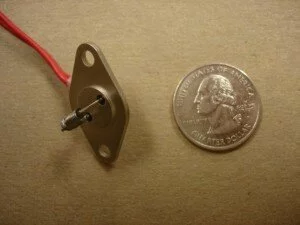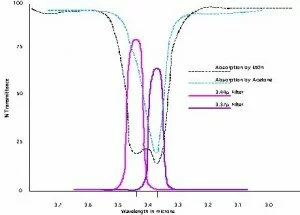
DataMaster DMT with Simulator Gas Tank Shown
Michigan exclusively uses the DataMaster to measure the breath alcohol of all persons arrested for drunk driving. The DataMaster operates on the scientifically accepted principle of absorption of infrared energy.
Michigan is about to put into service a new DataMaster called the DataMaster DMT. The analytical portion of the DMT is essentially identical to the analytical portion of BAC DataMaster and DataMaster CDM. The following explanation therefore applies to both breath analyzers.
After your breath has been tested for alcohol, the DataMaster will print out a breath test ticket containing the breath alcohol level or BrAC (breath alcohol content). Additionally, one of many status codes may also be printed.
One such status code is “INTERFERENCE DETECTED.” There is much confusion of the meaning of this code. The following explains in detail exactly what this status code means.
After the subject blows into the DataMaster and sample of his breath is captured inside the sample chamber. A beam of infrared light is broadcast from an infrared light source through the sample chamber and measured as it exits the sample chamber by a detector. A photograph of such an infrared source is shown here:

Example of Infrared Lights Source
There are two lenses at that are part of the optical bench, and these are contained on the optical block which is positioned just before the detector. In other words, the lenses are positioned between the end of the sample cell and the detector.
As the infrared light comes out of the sample chamber it passes through these lenses, which are often called “filters” or “optical filters,” before reaching the detector. Filter number 1 is 3.44 microns and is centered to read the “shoulder” of ethanol rather than the peak. Filter 2 is centered around 3.37 microns and reads the peak of ethanol.
The reason for this is to provide as much separation as possible between filter 1 and filter number 2. Both “see” the ethanol molecule but the 3.44 is much stronger in one part of the infrared signature as opposed to the 3.37. It is the change in the ratio of the difference between the 3.44 and the 3.37 optical filters that flags the INTERFERENCE DETECTED error message.
Here is a pictorial example of this concept:

Infrared Signature of Ethanol
The ratio might typically be 1.2 to 1 in terms of absorbance, and this is the expected ratio at any level. If that ratio changes enough to produce a corresponding ethanol value of at least .005 but selectable up to .020, it will flag interference. Usually it is set at .01 or .007 since the level of signal being produced is so small and close to the noise level of the electronics. Setting it too low will result in too many false interference readings.
One common interfering substance is acetone, but the 3.44 is not an “acetone filter” as is often claimed. The 3.44 optical filter should not be thought of in terms of an acetone filter since it is never known what kind of compound is present that may disturb the ratio. It could be acetone or any of a range of possible compounds. It could also be other factors such as a change in the signal between the time of the reading at the first filter and the time that the second is read. The best that can be said is that the ratio was out of tolerance and therefore interference will be flagged.
As explained below, this is NOT the same as Radio Frequency Interference.
3. INTERFERENCE DETECTED: If the expected ratio between the filters is exceeded the instrument will display and printout “INTERFERENCE”. Depending on your software, the test may or may not be aborted and a print of the results may or may not be done.
4. RADIO INTERFERENCE The RF Detection circuit has been activated. The instrument only “looks” for RF when the detector output is being monitored by the A to D converter. Whether or not the test results will be printed may be software dependent, but generally if the RF was not activated until after the completion of the subject blow, a valid test result will be returned and “Radio Interference” will be printed on the test report after the subject test. The RF circuit is not designed to detect all RF signals that may be generated, only those that are of sufficient strength.
The above explanations are taken from the DataMaster DMT Supervisor manual. I will be providing all CAP attendees with a copy of this manual next week at the CAP seminar.
Now that you know how the “INTERFERENCE DETECTED” state code arises the second part of your question is: what does this mean?
We know for sure that it means there was insufficient agreement between the two filters. Establishing more than that requires an investigation on your attorney who should be looking for reasons why your breath would have acetone.
Reasons might include being diabetic on a high protein diet. Alternatively, your lawyer should also investigate if you were exposed to other possible interfering substances in your home or work place. Such substances might include things such as toluene or other similar hydrocarbons.
{ 1 trackback }